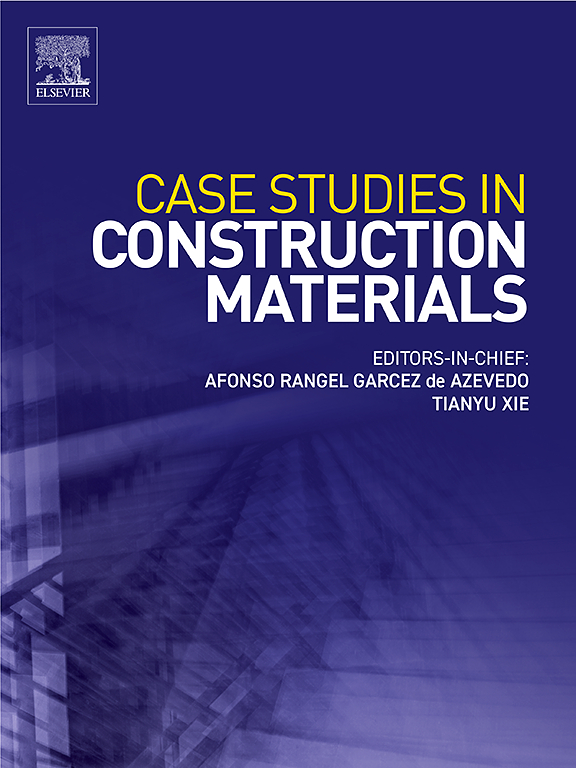边粘结预制SHCC板外加固环保型橡胶RC梁的抗剪性能
IF 6.6
2区 工程技术
Q1 CONSTRUCTION & BUILDING TECHNOLOGY
引用次数: 0
摘要
本研究提出了一种可持续的解决方案,通过重新利用橡胶作为钢筋混凝土(RC)梁的混凝土混合物中的沙子替代品。此外,它还检查了使用预制应变硬化胶凝复合材料(SHCC)板的橡胶梁的加强,以减轻混凝土混合物中橡胶掺入引起的极限载荷或延性的潜在降低。设计了一个试验方案,由16根半比例尺钢筋混凝土梁组成,在三点荷载下进行了剪切缺陷试验。该方案考察了再生橡胶在10 %、30 %和50 %的比例下替代砂的效果。此外,它还检查了加固板的布置,无论是垂直的还是与梁轴倾斜45°的,以及固定方法,使用单独的环氧树脂或环氧树脂与10 毫米钢锚的组合。结果表明:与全浇砂对照梁相比,仅用环氧树脂固定的竖向和倾斜SHCC板,将含10% %橡胶的橡胶梁的极限荷载分别提高了5 %和16 %。此外,用10% %橡胶浇铸并使用环氧树脂和钢锚固定的斜板加固的梁在试验中表现出最大的极限荷载和延性增加,相对于参考梁分别提高了32 %和85 %。除试验程序外,本研究还建立了考虑橡胶含量、加强板布置和固定方法的SHCC板加固橡胶梁极限荷载的分析模型。本文章由计算机程序翻译,如有差异,请以英文原文为准。
Shear behavior of environmentally friendly rubberized RC beams externally strengthened with side-bonded prefabricated SHCC plates
This research proposes a sustainable solution for discarded tire disposal by repurposing rubber as a sand replacement in concrete mixtures for reinforced concrete (RC) beams. Furthermore, it examines the strengthening of rubberized beams using prefabricated strain-hardening cementitious composite (SHCC) plates to mitigate potential reductions in ultimate load or ductility caused by rubber incorporation in the concrete mixture. An experimental program was designed, consisting of 16 half-scale RC beams with shear deficiencies tested under three-point loading. The program investigates the effect of replacing sand with recycled rubber at proportions of 10 %, 30 %, and 50 %. Additionally, it examines the arrangement of the strengthening plates, either vertical or inclined at a 45° to the beam axis, as well as the fixation method, using either epoxy alone or a combination of epoxy and 10 mm steel anchors. The results indicate that vertical and inclined SHCC plates, fixed with epoxy alone, enhanced the ultimate load of rubberized beams containing 10 % rubber by 5 % and 16 %, respectively, compared to the reference beam cast entirely with sand. Furthermore, the beam cast with 10 % rubber and strengthened with inclined plates fixed using both epoxy and steel anchors exhibited the highest increase in ultimate load and ductility among the tested specimens, with improvements of 32 % and 85 %, respectively, relative to the reference beam. In addition to the experimental program, this study develops an analytical model to predict the ultimate load of rubberized beams strengthened with SHCC plates, considering the rubber content, the arrangement of the strengthening plates, and the fixation method.
求助全文
通过发布文献求助,成功后即可免费获取论文全文。
去求助
来源期刊

Case Studies in Construction Materials
Multiple-
CiteScore
7.60
自引率
19.40%
发文量
842
审稿时长
63 days
期刊介绍:
Case Studies in Construction Materials provides a forum for the rapid publication of short, structured Case Studies on construction materials. In addition, the journal also publishes related Short Communications, Full length research article and Comprehensive review papers (by invitation).
The journal will provide an essential compendium of case studies for practicing engineers, designers, researchers and other practitioners who are interested in all aspects construction materials. The journal will publish new and novel case studies, but will also provide a forum for the publication of high quality descriptions of classic construction material problems and solutions.
 求助内容:
求助内容: 应助结果提醒方式:
应助结果提醒方式:


